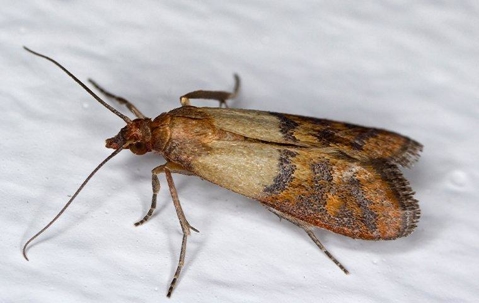Indian-meal moths are relentless household nuisances and some of the most common pests responsible for insect problems in the food industry. They thrive in a wide range of climates and are mostly found in stored-food products such as grains, flours, cereals, dried foods, nuts, rice, seeds, spices, certain candies, pet foods, and birdseed.
The Indian-meal moth gets its name from its notorious diet of grains and cornmeal, referred to as “Indian Meal” at the time of classification. It has a variety of nicknames, including the pantry moth, flour moth, grain moth, or weevil moth. Adult Indian meal moths have an elongated body measuring around 0.37 inches and can be characterized by their fluttering, zigzag flight pattern. Their front half is pale gray while their wings are coppery brown and folded tightly over their body.
Their life-cycle consists of 4 stages:
- The first is the egg which is deposited directly onto a food source, laid singly or in clusters. The eggs are about half a millimeter in size and are grayish-white. They take about 1-2 weeks to hatch (less in warmer temperatures) before entering the second stage of their lifecycle: larvae.
- Within hours of hatching, larvae find themselves a food source so they can begin feeding. Fully grown larvae are about half an inch long and have brown heads and dirty off-white bodies. The larval stage is when most of the damage is done. As they feed, they spin silken threads, webbing together particles of food, fecal droppings, discarded skin, and eggshells to create a protective casing.
- The larvae feed for around two weeks until they are ready to pupate. Pupae are usually located a considerable distance away from the site of infestation as the larvae oftentimes climb to other shelves and pantries before making their cocoons. Pupae measure around ¼ of an inch and are a pale, brown color. They spin their cocoons in unexpected cracks, crevices, pantry walls, and even ceilings.
- The pupae stage can last up to 30 days before adulthood. About three days after the adult emerges, they begin laying eggs and mating. A single female adult can lay around 300-500 eggs over a period of 18 days.
Indian-meal moths are extremely common in Texas homes and grocery stores. They are known as the most common and destructive stored-food pest in the United States as they can enter your house via stored-food products brought in from the outside. Eliminating an Indian-meal moth infestation can be a challenge because adults fly and spread the infestation. They can move great distances, traveling away from the initial food source to other rooms in the house.
In order to identify and prevent the infestation from spreading, you must examine all the goods in your pantry. Carefully inspect everything for white worms with black heads, cast skins, and fecal droppings in or around the stored goods. Examine loosely sealed foods, any packaging with holes or sticky webbing, and any items that have been on the shelf for a long time. All contaminated food should be disposed of immediately.
Common pantry foods are vulnerable to Indian-meal moth infestation because the larvae can eat through cardboard and soft plastic. They feed on protected areas like the ears of a bag, the flaps of a box, and other small cracks and crevices near stored foods. Items that may not look infested can, in fact, contain larvae or eggs.
To protect your home from rodents, it’s important to establish good sanitation and maintain proper food storage techniques. Keep all vulnerable items in airtight, insect-resistant containers. Keep your pantry clean. Avoid the accumulation of crumbs, and promptly clean up spills, especially fruit juices and sugary beverages. Regularly vacuum problem areas in the kitchen, such as cracks and crevices, and empty the vacuum right away to prevent re-infestation. Rotate dried food items and dispose of expired goods. Try not to purchase more food than you can use in a 2-4-month time frame because foods stored in bulk are more susceptible to infestation.
If you discover signs that indicate an Indian-meal moth infestation, it’s imperative to take action right away so the problem doesn’t spread. Adams Exterminating Company serves the greater Lewisville area with professional pest extermination services at an affordable rate. Call us today to receive a free quote so we can drive those pests out of your pantry and keep them out for good.

